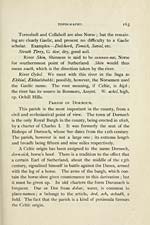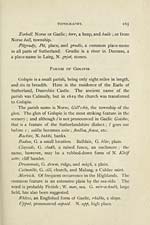Sutherland and the Reay country
(198) Page 164
Download files
Complete book:
Individual page:
Thumbnail gallery: Grid view | List view

164 SUTHERLAND AND THE REAV COUNTRY.
A new element enters into the topography of East Suther-
land — the Pictish or Brythonic. All along the north and west
coasts there is no trace of any dialect of Celtic, save the
Goidelic ; but it is clear the south-east formed part of Pict-
land. Here we meet with///, the Pictish equivalent of baile,
township ; also aber for inver, river-mouth. Initial p enters
more frequently into place-names on the east coast, another
sign of Pictish occupation.
Pitfour, Pictish,///, township, ox portion and Welsh paur,
pasture. The Pictish language is more nearly allied to the
Welsh than to the Gaelic. There are two Proucies, an
upper and lower; initial/, suggests a Pictish origin. There is
a Welsh word, Pren, meaning wood, which may be connected
with the root-meaning.
Achavandra, G. Andrew's field. There was a Bishop
Andrew at Dornoch, who had his floruit about 1150 a.d.
Achosnich, G. ach, oisneach ; cornered, field.
Ast/e, N. ash, dale.
Balvraid, G. baile, bhraighead, height.
Caamore, G. catha, a steep ascent, mbr, large.
Clasnagrave, G. clash, hollow, nan craoibh, of trees.
Clashmore, G large hollow.
Embo, N. bo for boll, township. The natives pronounce
it Eriboll in Gaelic, which comes from Norse eyrr, pebbly-
beach, and boll, town.
Skelbo, N. shell-town.
Lednabirichen, G. slope of heights, Mr is a point.
Fleucharey, G. Flinch, wet ; airidh sheiling.
Rearquhar, G. rhi, declivity ; the last part may be a
proper name.
Strathtollie, G. strath, and toll, hole, a fissure.
A new element enters into the topography of East Suther-
land — the Pictish or Brythonic. All along the north and west
coasts there is no trace of any dialect of Celtic, save the
Goidelic ; but it is clear the south-east formed part of Pict-
land. Here we meet with///, the Pictish equivalent of baile,
township ; also aber for inver, river-mouth. Initial p enters
more frequently into place-names on the east coast, another
sign of Pictish occupation.
Pitfour, Pictish,///, township, ox portion and Welsh paur,
pasture. The Pictish language is more nearly allied to the
Welsh than to the Gaelic. There are two Proucies, an
upper and lower; initial/, suggests a Pictish origin. There is
a Welsh word, Pren, meaning wood, which may be connected
with the root-meaning.
Achavandra, G. Andrew's field. There was a Bishop
Andrew at Dornoch, who had his floruit about 1150 a.d.
Achosnich, G. ach, oisneach ; cornered, field.
Ast/e, N. ash, dale.
Balvraid, G. baile, bhraighead, height.
Caamore, G. catha, a steep ascent, mbr, large.
Clasnagrave, G. clash, hollow, nan craoibh, of trees.
Clashmore, G large hollow.
Embo, N. bo for boll, township. The natives pronounce
it Eriboll in Gaelic, which comes from Norse eyrr, pebbly-
beach, and boll, town.
Skelbo, N. shell-town.
Lednabirichen, G. slope of heights, Mr is a point.
Fleucharey, G. Flinch, wet ; airidh sheiling.
Rearquhar, G. rhi, declivity ; the last part may be a
proper name.
Strathtollie, G. strath, and toll, hole, a fissure.
Set display mode to:
![]() Universal Viewer |
Universal Viewer | ![]() Mirador |
Large image | Transcription
Mirador |
Large image | Transcription
Images and transcriptions on this page, including medium image downloads, may be used under the Creative Commons Attribution 4.0 International Licence unless otherwise stated. ![]()
| Histories of Scottish families > Sutherland and the Reay country > (198) Page 164 |
|---|
| Permanent URL | https://digital.nls.uk/95320035 |
|---|
| Description | A selection of almost 400 printed items relating to the history of Scottish families, mostly dating from the 19th and early 20th centuries. Includes memoirs, genealogies and clan histories, with a few produced by emigrant families. The earliest family history goes back to AD 916. |
|---|

